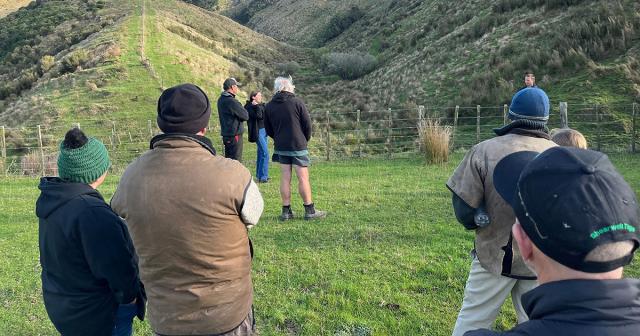Triple drench resistance is fast being a reality on many sheep and beef farms, and Tararua farmers Nick and Lesley Coppell are taking a multi-pronged approach to tackling the problem.

The couple recently hosted a Beef + Lamb New Zealand Farming for Profit field day on their 343ha property, Tui Farm, in the Hinemoa Valley.
While they are increasing cattle numbers to help reduce the overall sheep parasite challenge, this is just one of the strategies the couple has adopted. Others include lengthening their grazing rotation, seeding pastures with susceptible worms, cropping, cross-grazing, focusing on ewe condition, selecting worm resilient genetics, carrying fewer younger stock and using a novel drench.
Changing cattle policies
The couple is moving to include breeding cows in their farm system. These cows will complement their existing trading cattle policy and play an important role in pasture and parasite management. Due to the current cost of breeding cows, they have bought heifers which will be mated and the replacements retained.
Rotation length
Where possible, grazing rotation has been lengthened. This is to try and prevent sheep grazing too low in the sward where there can be high concentrations of L3 larvae.
Seeding with susceptible worms
The Coppells sourced lambs from a farm with no drench resistance and ran them onto new grass paddocks 10-14 after their last drench. These lambs were left for as long as possible without drenching. The idea being that these lambs would contaminate (“seed”) the new grass with susceptible worms.
Any lambs introduced after that time were drenched with Zolvix (drench tested to confirm efficacy) and left on that pasture for 10-14 days before being moved, therefore spreading the population of susceptible worms.
A 10-day post drench test in February confirmed that the Coppells’ flats now have a population of susceptible worms. This area is being used to spread susceptible worms over the rest of the farm.
Crops
Forage crops, grown as part of the Coppells’ pasture renewal programme, are used to provide relatively worm-free feed for lambs under 25kg until April, Lambs are stocked at around 60/ha.
Cross-grazing
Much thought goes into planning stock rotations to try and reduce worm burdens. Adult stock of the same species follow young stock and sheep and cattle follow each other. The couple try and avoid have one-stock class confined to one part of the farm e.g a hogget block.
Ewe condition
Nick and Lesley work to maintain ewes in optimum body condition all year round. Well-conditioned ewes can then be used to mop-up L3 larvae from the pasture. Prior to discovering they had triple resistance, the Coppells’ ewes had struggled to get up to and maintain body condition due to heavy parasite burdens.
Genetics
The couple run a terminal system using Texel rams over Highlander ewes. The Highlanders were bought-in to help built parasite resistance in the flock.
Novel drenches
In the year after they discovered they had triple drench resistance, the Coppells only used Zolvix. Now, as part of moving back to using triple drenches, they use Startect as a clean-up drench in autumn and use Zolvix for every third drench. The rest are triple drenches. The most recent drench checks have shown 100% efficacy of triple drenches on the farm’s flats.
Farming with drench resistance
Speaking at the field day, Simon Marshall from Vet Services Dannevirke said triple drench resistance is now widespread and the key points for farmers to remember were integrated grazing, refugia, monitoring and effective drenching.
He said having ewes in good body condition plays a major role in dealing with worm burdens and while the introduction of susceptible worms has worked for Nick and Lesley, it does have to be well planned and managed.
Simon said some farm systems may not be sustainable with triple drench resistance and would need to be reviewed.
Increasing cattle numbers
Matt Carroll, a farm consultant with Baker Ag, told attendees that when changing cattle policy, factors to consider included the opportunity cost, the financials- although they were only one piece of the puzzle, the protection of the farm system – particularly environmental factors and trading versus breeding cattle.
He said farmers also needed to consider what they enjoyed doing.
Breeding cows
One of the advantages of breeding cows is that they can lose up to 10% of their bodyweight over winter but do need to regain it by the time they go to the bull. This means that calving dates need to fit with the pasture growth curve. Depending on their farm system, farmers can choose to run maternal and or breeding terminal policies.
Trading cattle
Factors to consider include the farm’s pasture growth curve and pinch periods, the growth requirements of any animals purchased, the risk; 80% of trades are repeatable and 20% are a gamble, and available funding.
Matt said every farm needs to be assessed individually when determining cattle policies as there were so many options and factors to take into account. The move to more cattle not only needs to suit the farm, it needs to stack up financially.